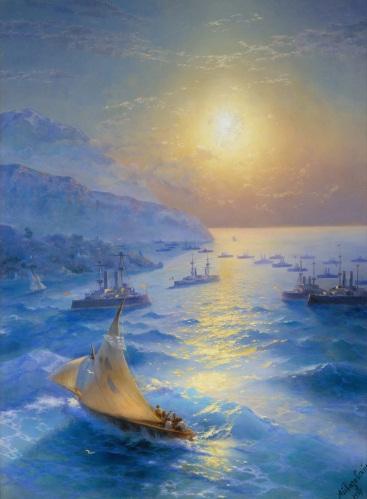
Ivan Constantinowitsch Aivazovsky
Russian, 1817-1900
Russian Fleet in Crimea, 1897
oil on canvas
55 1/2 x 42"
Michael Armand Hammer and the Armand Hammer Foundation
Loan

Alexey Tyranov, Portrait of Ivan Aivazovskiy, 1841. Oil on canvas. The Tretyakov Gallery, Moscow
COMMENTS
Ivan Aivazovskiy (1817-1900) was born to an Armenian family in the city of Theodosia in the Crimea. At the age of twenty he graduated from the Art Academy of St. Petersburg with a gold medal. He went to Italy to continue his studies and returned as an internationally acclaimed seascape painter. Neither financial security nor life in the Palace interested him. He returned to his native land, built a workplace on the seashore and, until the last days of his life, dedicated himself to the work that he loved.
Even in the early years, Aivazovskiy had a vivid and emotional understanding of reality. He always remained a romantic at heart even through his art could never separate itself from his academic background. The Artist's expressive language was in complete harmony with the techniques that he used. As a young boy Aivazovskiy had known the sea, had loved it passionately and had known the secrets of its movements. It was this memory, together with his imagination, that was responsible for his best works. Rather than merely "reproduce" the sea, Aivazovskiy tells us its fables and thus makes a symbolic statement.
One of the greatest seascape painters of his time, Aivazovsky conveyed the movement of the waves, the transparent water, the dialogue between sea and sky with virtuoso skill and tangible verisimilitude. The artist also often turned to themes from Armenian and Russian history. The originality of Aivazovsky's work is largely determined by his national character and temperament. Armenian culture has an ancient tradition of the creative value of light, and the knowledge of light was one of the most important elements in his art, giving the artist's canvases a dreamy and emotional feel. The perceptive viewer will observe that while painting the waves, clouds or sky space, the artist's emphasis is on the light. In Aivazovskiy's art light is the eternal symbol for life, hope and faith. This is light the creator, the concept of which has its roots deep down in Armenian culture and its continuity in the next generation of Armenian artists.
- "Ivan Aivazovskiy," Russian Paintings, Web, 2004-2013
http://www.russianpaintings.net/doc.vphp?id=445
"In this your picture
I see the moon, all gold and silver.
Reflected in the sea below...
And on the surface of the sea
There plays a breeze which leaves a trail
Of trembling ripples, like a shower
Of fiery sparks or else the gleaming headdress
Of a mighty king!
Forgive me if I err, great artist
Your picture has entranced me so
Reality and art are one
And I am all amazement.
So noble, powerful is the art
That only genius could inspire!"
- Joseph Mallord William Turner upon seeing Aivazovskiy 's painting, The Bay of Naples on a Moonlit Night
SBMA CURATORIAL LABELS
Like "Russian Fleet in Crimea," Aivazovsky's seascapes are especially admired for their play of light, an effect created through the overlay of color to create a transparent quality, rendering a realistic shimmer on the water of the light filtering through the clouds. These brilliantly illuminated seascapes are often peopled with soldiers at battle or sailors lost at sea, yielding a melodramatic or romantic mood to the composition. In "Russian Fleet in Crimea," the wooden boat full of Crimean sailors in the foreground, with its sails catching the sun's golden rays as well as the wind, stands in stark contrast to the modern naval cruisers which surround it.
- Degas to Chagall, 2013
